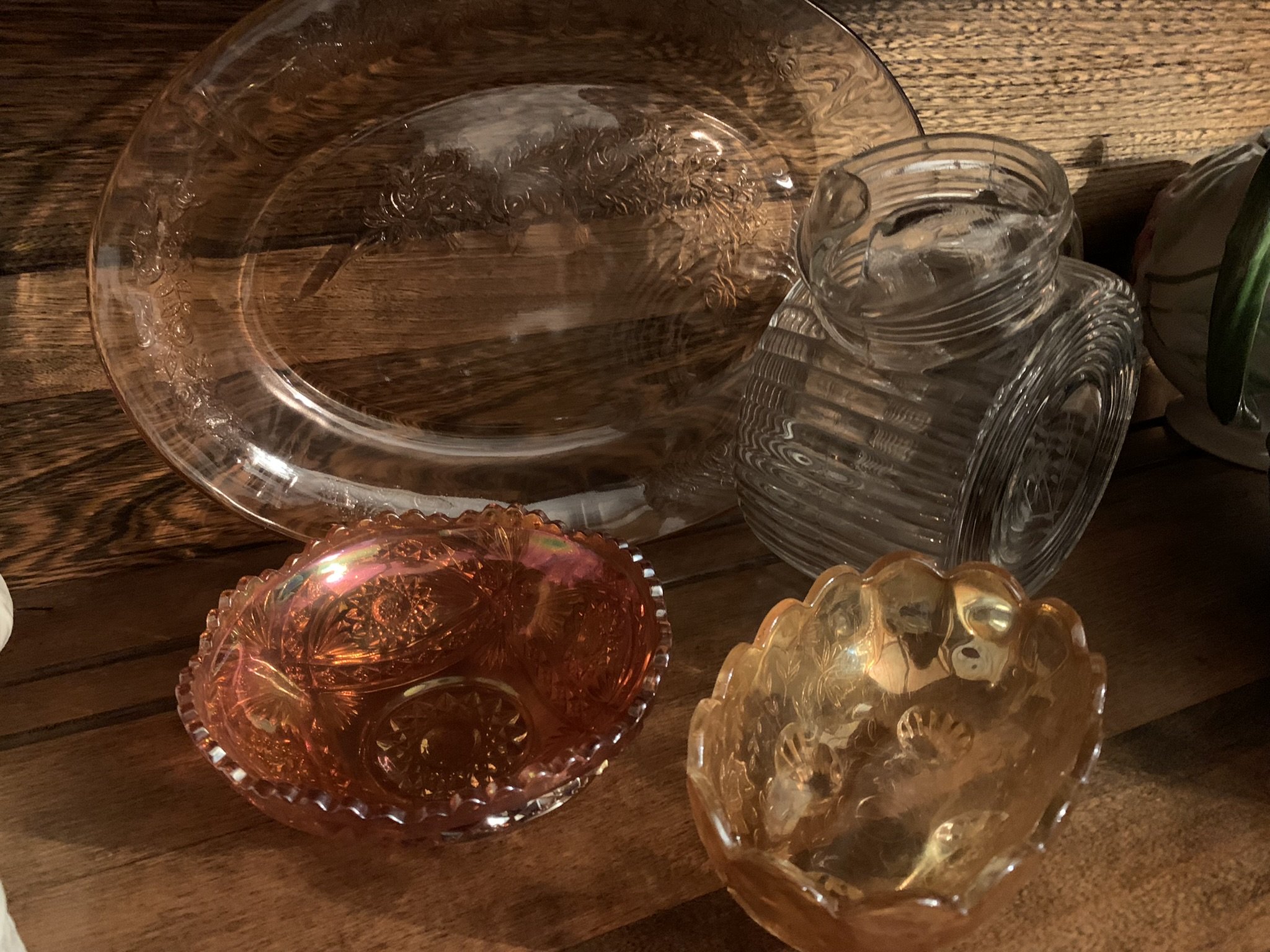On Glass
On glass
There are literally books and stores and historians which and who only talk glass.
Here are some key categories of glass I will feature on this site:
1) Carnival glass – mostly because it’s not too expensive and I think it’s just gorgeous. I got a little candy dish and one of my grandma’s tumblers years ago. There are some pieces which are rare and collectible and those will come with higher price tags.
Pink Depression glass platter, clear Depression glass pitcher (which I use when hosting my fairly big family for dinner) and two sweet carnival glass pieces - one from my grandma and one from my very nice mother-in-law. There's a story with each one, of course.
The common variety is those with grapes or leaves and a common colour is the marigold colour. The colours range wildly – Dugan glass is often such a dark amethyst it almost looks black. Then Northwood made a number of different kinds – the ice blue coloured items are quite rare.
Of course, like all vintage and antique items, the better the condition, the higher the price. Chips or cracks render these nearly without value.
2) Pressed glass – this glass is made by pressing into moulds, first made in 1825 to make knobs for furniture. Carnival glass is in fact a kind of pressed glass. This method was used extensively in the U.S. and Europe for a number of household items. On this site you will find some examples of pressed glass made by the Tarentum company in Pittsburgh (1894-1918). I came across a lot in excellent condition of the frost pattern, apparently found in a closet of an estate in Oxford County.
This is an excellent site to look up all of the Tarentum patterns:
https://magwv.pastperfectonline.com/bycreator?keyword=Tarentum+Glass+Company – from the Museum of American Glass
3) Art glass – I’ve just become recently fascinated with art glass. This has been coming into vogue with the MCM mania that’s seized vintage hunters and millennials. But it is a striking art form. I’ll soon be posting items by a pioneering art glass artist in Canada – Martin Demaine who was actually a U.S. citizen as well. Art glass is made by techniques which use a kiln – possibly the most difficult and delicate art form today. Anyone who has seen the Netflix series Blown Away will know what I’m talking about here. This glass can come from glass blowing (hence the Netflix series), sand blasting, copper-foiling, painting and engraving.
4) Milk glass – I’ve always LOVED milk glass. I’m not going to go into great detail here as I think milk glass deserves its own blog post. OK, I get it if you’re not as into weird stuff like this as I am, but if you are, keep an eye for that blog post.
Milk Glass
5) Depression glass – I think this kind of glass has for some reason fallen out of favour. When I just got married (30 years ago!!!), you could find all manner of Depression glass in antique stores. It just doesn’t seem to appeal to as many antique junkies. Just wait though, this is one trend that will be making a comeback. I was given a beautiful pink bread platter from my husband’s late grandmother who got it from her mother. It still takes a proud place in my china cabinet, creating a shiny backdrop.
Depression glass was in fact made largely from 1929 to 1939 and was largely distributed free as a promotional product by food manufacturers in the U.S. and Canada. Most colours of Depression glass are pink, yellow and clear or crystal. There are however some very unusual or rare pieces which are still not just collectible but highly sought after – uranium glass which is said to glow, some deviations of the common colours such as a pale pink or cobalt blue. Be careful not to fall for reproduction Depression glass or purchase anything with cracks or chips – these things also render this glass nearly without value.
When it comes to collecting vintage or antique glass, if you really like one kind or you want to know what something is worth check out http://www.justglass.com/. It’s just an awesome site which has so much information you’ll be amazed. If you really want to nerd out, you can read a dizzying list of articles at the online National Depression Glass Association museum - http://www.ndga.net/index.php. There are a number of excellent newsletters on various glasses, not just Depression glass.
If you are curious about Canada's glass history - you know you are - check out https://www.historymuseum.ca/cmc/exhibitions/hist/verre/vecan01e.html. Some interesting info about Hamiton's own Dominion glass works.
Happy hunting.
L


